What happens when an architect and a businessman, with neighbouring offices in a dated urban strip, join forces to redevelop their heritage-listed locale?

What happens when an architect and a businessman, with neighbouring offices in a dated strip of an urban area, decide to join forces and reinvigorate their heritage-listed locale? Look to the recently redeveloped Stanley Street precinct in the inner-city suburb of Woolloongabba, Brisbane, and there’s your answer: an exemplar of masterfully considered urban revitalisation.

The reactivated precinct is the result of a fortuitous meeting of minds, between Brisbane-based architect James Davidson, director of JDA Co., and Steve Wilson, a local businessman and the project’s primary benefactor. Instigated by Wilson — whose office is neighbour to Davidson’s studio JDA Co. on the first floor of the Stanley Street strip — the project’s primary motive was to elevate Stanley Street to be amongst Brisbane’s best strips.
“Cities are not defined by their suburbs, they’re defined by memorable streets — those that have significant character, history and form,” explains Wilson. “Our ambition is to transform the street into a central hub where artists, musicians, designers, entrepreneurs and business owners can live, work and play in a truly creative environment.”

And who better to lead the design than the architect next door. “This project features a series of interconnected and overlapping functions,” Davidson says. Originally known as ‘Shop Row’ and built in the early 1900s, the strip is now home to French restaurant C’est Bon, rooftop bar Le Bon Bar, the JDA Co. design studio, and, of course, Wilson’s office.
“The architectural challenge was to navigate what is essentially a three-dimensional jigsaw into one harmonious and cohesive design,” says Davidson.
Responsible for both the overarching master plan and the redesign of its individual spaces — many of which are heritage-listed — JDA Co.’s approach is a masterclass in constraint and careful consideration. “I wanted to honour the precinct’s history yet enliven the strip in a way that introduces a new dynamism to the area,” says the architect.


C’est Bon is a good case in point. Here, Davidson’s fresh fit-out involved the removal of internal petitioning to open up the interior to better engage with the streetscape. Likewise, the addition of outside planter boxes form a subtle yet effective barrier to passing traffic, whilst allowing patrons to view the passing parade of cyclists making use of Brisbane City Council’s new bike path.
Inside, the original tongue-and-groove timber ceilings and sandstone and brick walls were lovingly repaired and restored. Meanwhile, the installation of an arched frame over the bar allowed Davidson’s team to add lighting without compromising original building materials. Outside, a new terrace marries ‘old’ and ‘new’ thanks to the use of patterned bricks in shades and shapes that tie in with the hues and patterns found throughout the neighbourhood — particularly, at the nearby Mater Hospital.

Turning his attention skyward, James also designed a new rooftop bar, known as Le Bon Bar. “We designed the structure to sit atop the heritage walls of the existing building,” Davidson explains. “In essence, it’s perched on a platform that is supported on a series of legs that carefully attach to the existing heritage walls.”
Due to access restrictions, the JDA Co. team deployed laser scanning to precisely measure the space, then worked closely with engineers to design balustrading, stair access, guttering, and provisions for power and waste removal. Cleverly, the orientation of the bar favours the east, providing patrons with a bird’s eye view out over Mater Hill and nearby sporting stadium, The Gabba. Incredibly, the bar is inconspicuous from the street — an attempt by James to not obscure the design of the original façade.

For Wilson’s office, high arched ceilings and an abundance of natural light provide a sense of welcoming grandeur and significant space. The added advantage is views out to the Princess Theatre — another of the businessman’s acquisitions (purchased together with The Tivoli owners Steve Sleswick and Dave Sleswick) that forms part of the precinct revitalisation. According to Wilson, James was the perfect choice for its redesign.
“James has the ability to interpret the soul of a place and to deploy design to preserve and protect that feeling well into the future,” he says. “Ours is a collaborative approach where we challenge each other in such a way that, ultimately, leads to better project outcomes.”
INDESIGN is on instagram
Follow @indesignlive
Join our collection to add your product.
Keep up to date with the latest and greatest from our industry BFF's!
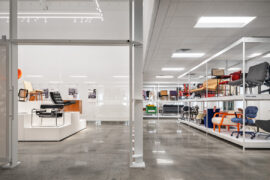
The undeniable thread connecting Herman Miller and Knoll’s design legacies across the decades now finds its profound physical embodiment at MillerKnoll’s new Design Yard Archives.
The new range features slabs with warm, earthy palettes that lend a sense of organic luxury to every space.
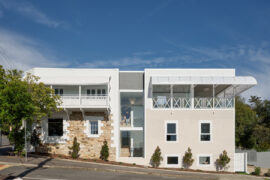
Jesse Lockhart-Krause, Director of Lockhart-Krause Architects, tells us about a storied building in Queensland that has now become a functional workplace for a therapy centre.
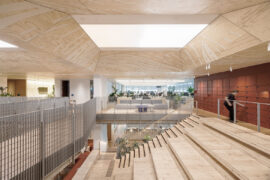
Reuse, resourcefulness and material transformations bring unexpected stories to Arup’s new Brisbane office, designed by Hassell.
The internet never sleeps! Here's the stuff you might have missed

Welcomed to the Australian design scene in 2024, Kokuyo is set to redefine collaboration, bringing its unique blend of colour and function to individuals and corporations, designed to be used Any Way!
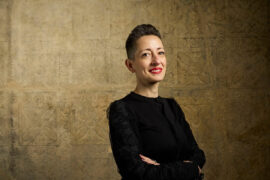
As French-Lebanese Architect Lina Ghotmeh prepares for lectures in Melbourne and Sydney, we hear about the philosophy shaping her internationally celebrated practice.
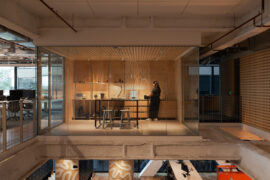
The Arup Workplace in Perth/Boorloo, designed by Hames Sharley with Arup and Peter Farmer Designs, has been awarded The Work Space at the INDE.Awards 2025. Recognised for its regenerative design, cultural authenticity, and commitment to sustainability, the project sets a new benchmark for workplace architecture in the Indo–Pacific region.